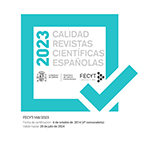Hacía una teoría social post-humanista: el caso del síndrome de cautiverio
Abstract
This article argues that post-humanist theory should not be understood as signaling the “end of the human” and the advent of new post-human world, but as a new form of posing the question, and the study, of the human. Hence, it will argue that, instead of establishing a duality between humanism and post-humanism, it is advisable to talk about two kinds of humanism: an abstract humanism that postulates the human as an atemporal and transcendental essence, on the one hand, and, on the other, an immanent humanism that understands the human as emerging from, and remaining within, an endless play of relations with the nonhuman. This argument will be defended empirically through a specific case-study: locked-in syndrome patients. This case will reveal in a practical way the specific play of relations between humans and nonhumans that draws the boundaries of our condition as moral and autonomous subjects.Downloads
Article download
License
In order to support the global exchange of knowledge, the journal Política y Sociedad is allowing unrestricted access to its content as from its publication in this electronic edition, and as such it is an open-access journal. The originals published in this journal are the property of the Complutense University of Madrid and any reproduction thereof in full or in part must cite the source. All content is distributed under a Creative Commons Attribution 4.0 use and distribution licence (CC BY 4.0). This circumstance must be expressly stated in these terms where necessary. You can view the summary and the complete legal text of the licence.











